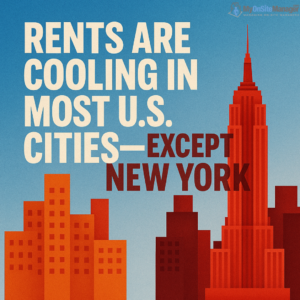After years of relentless rent hikes, renters in many parts of the United States are finally getting a break. According to Realtor.com’s February 2025 Rental Report, rent prices are cooling across a majority of major U.S. cities. The national median asking rent dropped to $1,691—a $15 decrease compared to last year. This marks the 19th consecutive month of year-over-year rent declines, a sign that the once red-hot rental market is stabilizing.
But not every city is seeing relief. One major metro is bucking the trend—and making headlines for it.
What’s Fueling the Rent Cooldown?
Several forces are contributing to the widespread easing of rent prices:
-
Pandemic Boom Reversal: The surge in rental demand during the pandemic drove prices to historic highs. Now, that demand has cooled.
-
New Supply in Key Markets: Cities that encouraged multifamily construction over the past few years are seeing the benefits as new units hit the market.
-
Economic Uncertainty: Slower job growth and inflation concerns have made renters more cautious, reducing competition and putting downward pressure on prices.
However, this cooling trend is fragile—and potentially temporary.
Why Developers Are Slowing Down
While renters may welcome the price drop, developers aren’t cheering. In 2024, only 294,000 new multifamily housing units were permitted—the lowest number since 2017. That’s a drop from 318,000 units permitted in 2020.
The reason? Lower rents mean lower profit margins for builders and investors. As a result, many are pausing or canceling new projects. If this slowdown continues, the limited future supply could eventually swing the market back in landlords’ favor.
“Today’s relief may be tomorrow’s shortage if we don’t keep building,” says Joel Berner, senior economist at Realtor.com.
The Outlier: New York City
While rents are falling elsewhere, New York City is defying the trend. The Big Apple saw a 7% increase in its median rent, reaching $2,977. That’s nearly $1,300 more than the national average.
Why the spike? A mix of high demand, slow permitting, and limited housing stock:
-
NYC issued just 42,230 permits for new apartments in 2024.
-
That’s down nearly 10% from 2019 levels.
-
With few new units coming online, competition remains fierce—and landlords are capitalizing on it.
New York isn’t alone. Other cities facing rising rents due to constrained supply include:
-
Boston, MA
-
Baltimore, MD
-
Detroit, MI
-
San Jose, CA
Cities Where Rent Is Dropping Fastest
Fortunately, not every city is struggling. The biggest rent decreases were seen in places that have ramped up construction in recent years:
-
Denver, CO: –6.4% (Median rent: $1,773)
-
San Diego, CA: –6.0% (Median rent: $2,667)
-
Birmingham, AL: –5.4% (Median rent: $1,165)
-
Austin, TX: –4.8% (Median rent: $1,462)
-
Phoenix, AZ: –3.1% (Median rent: $1,492)
These cities show that building more units works. More supply = more options = more affordable rents.
Takeaways for Renters and Policymakers
The data tells a clear story: rents can cool when housing supply increases, and they rise when it stalls. For renters, this is both good and bad news.
-
The good: Relief is here—especially in markets that invested in housing.
-
The bad: Places like New York and San Jose are still out of reach for many.
-
The warning: If construction slows too much, today’s gains could be erased in a few years.
Policymakers and city leaders should take note. To ensure long-term affordability, cities must:
-
Streamline permitting and zoning laws
-
Invest in infrastructure for multifamily housing
-
Incentivize developers to build in high-demand areas
Final Thoughts
While most renters are finally catching a break, the future of rent affordability hinges on decisions being made today. Whether you’re a tenant, landlord, policymaker, or developer, the message is clear: we must keep building to keep rents in check.
Source: Rents Are Cooling in Most US Cities, Except in This One

